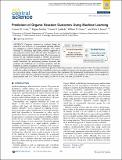Prediction of Organic Reaction Outcomes Using Machine Learning
Author(s)
Coley, Connor W.; Barzilay, Regina; Jaakkola, Tommi S.; Green, William H.; Jensen, Klavs F.; Coley, Connor Wilson; Jaakkola, Tommi S.; Green, William H.; Jensen, Klavs F.; ... Show more Show less
DownloadPrediction of organic reaction.pdf (1.706Mb)
PUBLISHER_POLICY
Publisher Policy
Article is made available in accordance with the publisher's policy and may be subject to US copyright law. Please refer to the publisher's site for terms of use.
Terms of use
Metadata
Show full item recordAbstract
Computer assistance in synthesis design has existed for over 40 years, yet retrosynthesis planning software has struggled to achieve widespread adoption. One critical challenge in developing high-quality pathway suggestions is that proposed reaction steps often fail when attempted in the laboratory, despite initially seeming viable. The true measure of success for any synthesis program is whether the predicted outcome matches what is observed experimentally. We report a model framework for anticipating reaction outcomes that combines the traditional use of reaction templates with the flexibility in pattern recognition afforded by neural networks. Using 15 000 experimental reaction records from granted United States patents, a model is trained to select the major (recorded) product by ranking a self-generated list of candidates where one candidate is known to be the major product. Candidate reactions are represented using a unique edit-based representation that emphasizes the fundamental transformation from reactants to products, rather than the constituent molecules’ overall structures. In a 5-fold cross-validation, the trained model assigns the major product rank 1 in 71.8% of cases, rank ≤3 in 86.7% of cases, and rank ≤5 in 90.8% of cases.
Date issued
2017-04Department
Massachusetts Institute of Technology. Computer Science and Artificial Intelligence Laboratory; Massachusetts Institute of Technology. Department of Chemical Engineering; Massachusetts Institute of Technology. Department of Electrical Engineering and Computer ScienceJournal
ACS Central Science
Publisher
American Chemical Society (ACS)
Citation
Coley, Connor W.; Barzilay, Regina; Jaakkola, Tommi S. et al. “Prediction of Organic Reaction Outcomes Using Machine Learning.” ACS Central Science 3, 5 (April 2017): 434–443 © 2017 American Chemical Society
Version: Final published version
ISSN
2374-7943
2374-7951